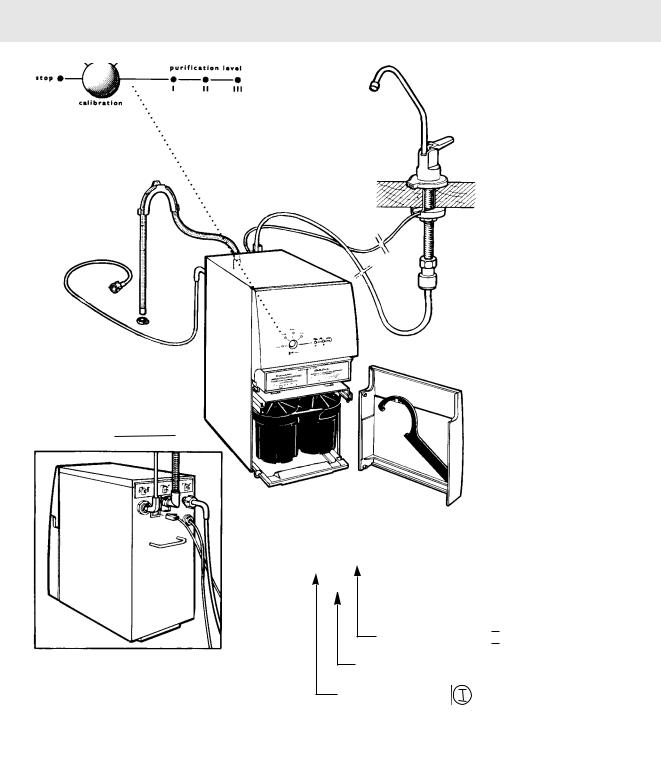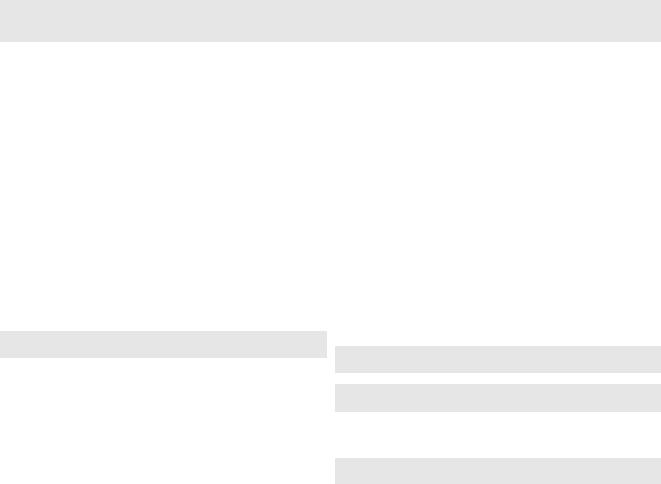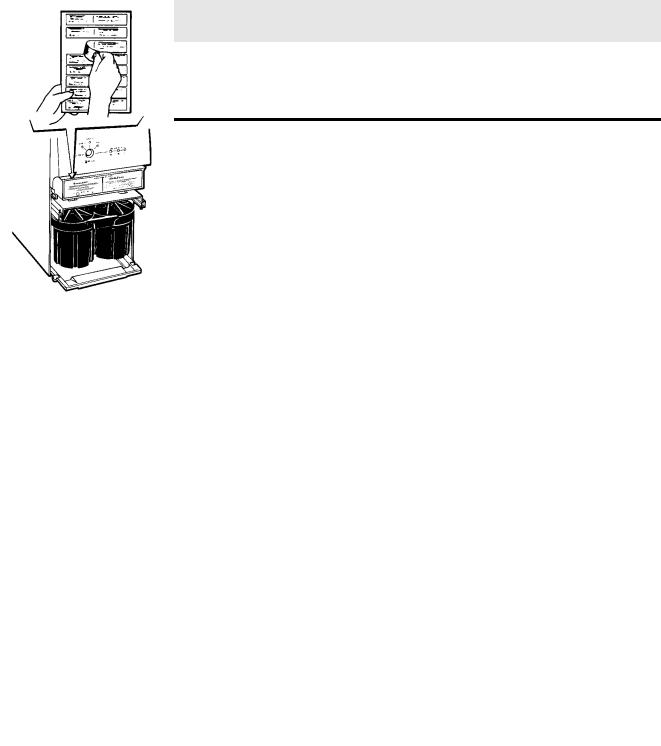AEG-Electrolux RO400 User Manual

I N F O
U S E R M A N U A L
WATER PURIFIER RO 400 DIRECT FLOW
822 90 16-13

RO 400 DIRECT FLOW
THANK YOU for choosing the RO 400 water purifier. We are confident it will give you many years of trouble-free service.
To achieve the best results when using your new water purifier, we recommend that you read this user manual carefully and keep it in a safe place for future reference.
To prevent mishaps and problems it is important that you should read the "Safety information" section, and that you follow the "Installation" instructions carefully. Everybody using the water purifier should be familiar with how to operate it and its safety features.
Take care of this manual and make sure that it accompanies the water purifier if it is moved or sold, so the user will always have access to the full instructions and the safety information.
To help you identify warnings and other important information we have used this symbol to gain your attention: 
While reading the manual you will find it useful to open out this folded page so you can refer back to the illustration "General View of the Appliance".
2

GENERAL VIEW OF THE APPLIANCE
|
|
|
|
|
|
|
10 |
|
|
|
|
||||||
|
|
|
|
|
11 |
|||
1 |
||||||||
|
||||||||
|
|
|
|
|
||||
|
|
|
|
|
|
|
|
|
2 |
|
|
|
|
|
|
|
|
|
|
|
|
|
|
|
||
|
|
|
|
|
|
|
|
|
|
|
|
9 |
||||
|
|
|
|
|||||||||||||
3 |
|
|
|
|
|
|
|
|
|
|
|
|
|
|
|
|
|
|
|
|
|
|
|
|
|
|
|
|
|
|
|
||
4 |
|
|
|
|
|
|
|
|
|
|
|
|
|
|||
|
|
|
|
|
|
|
|
|
|
|
|
|
|
|
|
|
|
5 |
|
|
|
|
|
|
|
|
|
|
|
|
|
|
Control panel |
|
||||||||||||||||
|
|
|
|
|
|
|
|
|
|
|
|
|
|
|
||
|
|
|
|
|
|
|
|
|
|
8 |
||||||
|
|
|
|
|
||||||||||||
|
|
|
|
|
|
|
|
|
|
|
|
|
|
|
|
|
|
|
|
6 4 |
|
|
|
|
|
|
|
||||||
|
|
|
|
|
|
|
|
|
|
|
7 |
|||||
|
|
|
|
|||||||||||||
|
|
|
|
|
|
|
|
|
|
|
|
|
|
|
|
|
|
|
|
|
|
|
|
|
|
|
|
|
|
|
|
|
|
Filter container 
Base plate
Filter container
Supplied with the RO 400:
1 |
Bracket for reject water hose* |
6 |
Elbow for purified water hose* |
2 |
Hose for discharge of reject water to |
7 |
Filter spanner |
3 |
waste pipe |
8 |
Self-adhesive information panel |
Connection piece, reject water hose* |
9 |
Hose for purified water |
|
4 |
Hose clip (x 2)* |
10 |
Tap for purified water |
5 |
Hose for feed water |
11 |
Indicator lights |
* packed in a separate bag
3

YOUR NEW WATER PURIFIER
Unpacking
If the appliance has been damaged during transportation, you should immediately notify the company responsible for delivering it.
Take hold of the rear hand-grip and the front edge of the RO 400 and carefully lift the appliance out. The appliance can be damaged if it is lifted in any other way. Check the water purifier for any signs of damage and check that no accessories are missing. If you do discover any damage, faults or that anything is missing, you should report this to the seller immediately. Never leave packaging material in a place where children may play with it.
Recycling of materials
The materials used in 80% of the plastic and rubber components of this product and its packaging are identified by symbols to assist the process of recycling and disposal. The materials are marked according to international standards. The cardboard parts of the packaging are made from recycled paper and should be deposited at a suitable recycling point.
Optional accessories and consumables
Filter inserts: |
|
|||||
Filter |
|
|
|
(particle filter) |
Part no. 919 24 00-00 |
|
|
|
|||||
Filter |
|
|
|
|
(carbon filter) |
Part no. 919 24 00-01 |
Descaling/cleaning agent |
|
|||||
|
|
|
|
|
|
|
for Water Purifiers |
Part no. 150 72 07-00 |
|||||
Preservative and Antifreeze |
|
|||||
liquid for Water Purifiers |
Part no. 150 72 06-02 |
|||||
Disinfectant for |
|
|||||
Water Purifiers |
Part no. 150 72 56-02 |
|||||
Water Extraction Device |
|
|||||
for Water Purifiers |
Part no. 919 24 09-01 |
|||||
Connector for dishwashers |
|
|||||
(level-control type only) |
Part no. 919 24 09-02 |
|||||
Accessories and consumables can be ordered from your Electrolux dealer. When ordering, please quote the relevant part number from the list above.
A BRIEF GLOSSARY
Reverse osmosis |
- The purification of water by forcing it under |
|||||
|
pressure through a semipermeable membrane. |
|||||
|
The membrane is impermeable to impurities, |
|||||
|
but permeable to water. This is the principle |
|||||
|
upon which the RO 400 is based. This form |
|||||
|
of purification does not rely on chemicals. |
|||||
Membrane |
- The membrane made of semipermeable |
|||||
|
material used in the RO 400 to purify water |
|||||
|
by reverse osmosis. |
|
|
|||
Filters |
- Used to separate out material before the water |
|||||
|
reaches the membrane, prolonging the life of |
|||||
|
the membrane: |
|
|
|||
|
grid (a coarse filter) |
|
|
|||
|
particle filter (Filter |
|
|
) |
||
|
|
|||||
|
carbon filter (Filter |
|
|
|
|
) |
|
|
|
|
|
||
|
|
|
|
|
||
|
|
|
|
|
|
|
4

CONTENTS
GENERAL VIEW OF THE APPLIANCE |
3 |
|
USING THE RO 400 |
|
13 |
|
|
|
To draw purified water |
.................................. |
13 |
YOUR NEW WATER PURIFIER |
4 |
|
|||
|
|
|
|
||
|
MAINTENANCE |
|
14-19 |
||
|
|
|
|
||
Unpacking........................................................ |
4 |
|
|||
|
Replacing the filters |
|
14-15 |
||
Identification of materials ................................ |
4 |
|
|
||
Optional accessories and consumables .......... |
4 |
|
Descaling ...................................................... |
|
16 |
A brief glossary................................................ |
4 |
|
Disinfection .................................................... |
|
17 |
|
|
|
To clean the grid ............................................ |
|
18 |
|
|
|
Preparing the RO 400 |
for storage |
18 |
CONTENTS |
5 |
||||
|
|
|
Protecting the RO 400 |
against freezing |
|
|
|
|
|||
|
|
|
during storage |
|
19 |
SAFETY INFORMATION |
6-7 |
|
|||
Concerning the use of the RO 400 .................. |
7 |
|
REGULAR CARE OF THE RO 400 |
19 |
|
Concerning installation and service ................ |
7 |
|
Points to remember ...................................... |
|
19 |
INSTALLATION |
8-12 |
Where to install the RO 400 ............................ |
8 |
Apply the information panel ............................ |
8 |
Electrical and plumbing connections .............. |
9 |
To fit the tap for purified water ........................ |
9 |
Connecting the reject water hose .................. |
10 |
Connecting the feed water hose.................... |
10 |
Connecting up the appliance ........................ |
11 |
The flushing procedure.................................. |
12 |
Calibration .................................................... |
12 |
Moving the RO 400........................................ |
12 |
TECHNICAL DATA |
20-21 |
IF THE RO 400 STOPS WORKING |
22-24 |
Trouble-shooting table.............................. |
22-23 |
To adjust the tap ............................................ |
24 |
SERVICE AND SPARE PARTS |
25 |
Service and spare parts ................................ |
25 |
5

SAFETY INFORMATION
The RO 400 Direct Flow is a very safe appliance, but even so it is important that everyone using it should be thoroughly familiar with the way it works and its safety features. To prevent mishaps and problems you should read the "Safety Information" on these pages, and carefully follow the instructions in the "Installation" section. Take care of this manual and make sure that it accompanies the water purifier if it is moved or sold.
•Check that the water you intend to purify meets the requirements listed under "Requirements of feed water", in the section "Technical data".
•When the RO 400 is brand-new, the purified water must not be consumed until after the calibration and flushing procedures have been completed.
•Calibration of the RO 400 should only be carried out:
–the first time that the water purifier is used
–if the appliance is moved to a different place (locality) where the water quality is different
–after the membrane has been replaced
•When the RO 400 is new or the membrane contains the special products for storage or descaling, it will have to be cleaned by following the "Flushing procedure" before the water from the water purifier may be used again.
•The water produced by the appliance may only be consumed if Purification Level indicator II or III on the control panel was lit when it was being purified. A green indicator light on the tap will come on at the same time.
•If the feed water supply to the appliance is unfit for consumption, have the purified water from the appliance tested after installation. You should subsequently have the purified water tested once a year, or if any change in its taste or smell occurs, to ensure that the water purifier is functioning well. If the result is unsatisfactory, do not drink the water. Contact your dealer.
•If any leakage arises, turn off the supply of water to the appliance immediately and disconnect the appliance from the electrical supply by removing the electrical plug from the wall socket, or if necessary, removing the relevant fuse (or switching off a circuit breaker) at the electrical distribution board (consumer unit).
•If the temperature in the room where the RO 400 is stored is likely to fall below 0 °C, the appliance must be protected by following the "Protection against freezing" procedure.
•Do not attempt to modify or otherwise alter the RO 400 in any way. Doing so could result in personal injury and/or damage to property which would not be covered by any warranty.
•Once every month you should check that the connections are all watertight. Leakages outside the appliance cannot be detected by the appliance's leakage protection system.
•If the water purifier is malfunctioning, it should be isolated from the electrical supply by removing the electrical plug from its socket. If this is not possible, remove the relevant fuse or switch off the circuit breaker at the electrical distribution board (consumer unit).
•At the end of the appliance's useful life, disconnect the electrical plug from the power supply, then cut the electrical lead at the point where it enters the appliance. Make quite sure that children will not be able to play with the severed lead and plug.
To find out how best to dispose of the appliance, contact your dealer or the local authority.
6

SAFETY INFORMATION
Concerning the use of the RO 400
•The RO 400 is designed to produce the quantity of water normally required for cooking, drinks, washing dishes and general household duties.
•The appliance needs to remain connected to the water and electrical supplies so that its automatic flushing system can work. The appliance will carry out flushing automatically every 12 hours (approximately).
•The appliance must not be operated without the filters (inside the filter containers) being in place (except during the descaling or storage procedures). Doing so can cause serious damage.
•If the tap is left on for longer than 20 minutes the RO 400 will shut down automatically. The appliance is designed to do this mainly to maximise the service life of the membrane. To restart the appliance, follow the instructions in the "Troubleshooting table".
•Depending on the incoming water quality it could be a delay of up to 60 sec. before the RO 400 indicates that the optimum water purification level has been reached. This is due to that the appliance has not been used for some time, which means that the membrane has not been under pressure. The concentration of impurities tends to equalise on both sides of the membrane.
•The top of the water purifier should not be used as a place for storing anything.
•Do not use the water from the appliance in aluminium saucepans etc., on account of the risk of corrosion, which would also cause increased levels of aluminium in foods cooked in the saucepan.
•The appliance will flush automatically after water is drawn from it and also whenever the electrical supply is reconnected. See "To draw purified water".
Concerning installation and service
•The water purifier must be connected to an earthed electrical supply. We recommend use of a plug-in connection to a wall socket, since certain procedures such as replacing filters and preparing the appliance for storage if it will not be used for a time require the power supply to be disconnected, then reconnected. Using an electrical plug also makes it easier to move the appliance.
•If the appliance is to have fixed wiring to the electrical supply, this work must be carried out by a qualified tradesman. Installation work which has not been carried out properly can result in personal injury and/or damage to property which are not covered by any warranty.
•Any plumbing work required should be carried out by a qualified tradesman. If you do any of the installation work yourself, you must check the regulations which apply to this and comply with them.
•It is important that the water purifier should be installed in the upright (standing) position.
•Make sure that hoses and leads do not get crushed or otherwise damaged when the water purifier is being moved, e.g. during installation or cleaning.
•The water purifier must not be plumbed in to supply the entire dwelling with water, since this could cause corrosion inside water pipes and other plumbing fittings and hot water heaters. For the same reason, no tap should be used for drawing the water from the appliance other than the one supplied or one recommended by your dealer.
7

INSTALLATION
You should read the section entitled "Safety Information" before starting work on the actual installation of the water purifier.
Where to install the RO 400
This water purifier can be installed in several different |
A |
|
|
|
ways. We will describe the most suitable of these. No |
|
|
|
|
|
|
|
||
matter which method you choose, there are certain points |
|
|
|
|
which you should be careful to observe: |
|
|
|
|
• |
The RO 400 must be installed in the upright position. |
|
|
|
• |
The area where it is installed must have access to a cold |
|
|
|
|
water supply, a normal domestic waste pipe (drain) and an |
|
|
|
|
electrical supply. |
|
|
|
• It must be easy to inspect the control panel on the |
|
|
|
|
|
appliance. |
|
|
|
• |
There must be enough space for the front cover to be |
|
|
|
|
opened and for good access to the filter containers. |
|
|
|
• |
When choosing the site, make sure there will be adequate |
|
|
|
|
|
B |
||
|
ventilation all around the appliance. There must be a gap of |
|
|
|
|
|
|
|
|
|
20 mm between the sides of the RO 400 and any adjacent |
|
|
|
|
fitments or walls. The connection points of the RO 400 |
|
|
|
|
allow you to route hoses and cables in any direction out |
|
|
|
|
from the appliance. The dimensions required for the |
|
|
|
|
installation site are shown in Fig. A. When installing the |
|
|
|
|
appliance, make quite sure that none of the service |
|
|
|
|
connections get crushed or otherwise damaged. |
|
|
|
Apply the information panel
In the box of accessories you will find a sheet of selfadhesive information panels in several languages. Select the language required and apply the printed panel to the part of the appliance shown in Fig. B.
8
